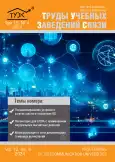Routing Task in Dynamic Fog Computing Network
- Authors: Volkov A.N.1
-
Affiliations:
- The Bonch-Bruevich Saint Petersburg State University of Telecommunications
- Issue: Vol 10, No 4 (2024)
- Pages: 27-37
- Section: ELECTRONICS, PHOTONICS, INSTRUMENTATION AND COMMUNICATIONS
- URL: https://journals.rcsi.science/1813-324X/article/view/263506
- EDN: https://elibrary.ru/QWBVQY
- ID: 263506
Cite item
Full Text
Abstract
Keywords
About the authors
A. N. Volkov
The Bonch-Bruevich Saint Petersburg State University of Telecommunications
Email: artem.nv@sut.ru
ORCID iD: 0009-0002-4296-1822
SPIN-code: 1311-9824
References
- Кучерявый А.Е., Маколкина М.А., Парамонов А.И., Выборнова А.И., Мутханна А.С., Матюхин А.Ю. и др. Модельная сеть для исследований и обучения в области услуг телеприсутствия // Электросвязь. 2022. № 1. С. 14−20. doi: 10.34832/ELSV.2022.26.1.001. EDN:GBQWCV
- Волков А.Н., Мутханна А.С.А., Кучерявый А.Е., Бородин А.С., Парамонов А.И., Владимиров С.С. и др. Перспективные исследования сетей и услуг 2030 в лаборатории 6G Meganetlab СПбГУТ // Электросвязь. 2023. № 6. С. 5−14. doi: 10.34832/ELSV.2023.43.6.001. EDN:CJSYLS
- Volkov A., Muthanna A., Koucheryavy A. AI/machine learning for ultra-reliable low-latency communication // ITU News Magazine. 2020. Iss. 5. PP. 65−68.
- Лавшук О.А., Листопад Н.И. Метод маршрутизации в сетях IIoT с использованием кластеризации для протокола RPL // Проблемы физики, математики и техники. 2023. № 4(57). С. 74−80. doi: 10.54341/20778708_2023_4_57_74. EDN:RVSCGG
- Mariocco C., Doshi K., Guim Bernat F.G., Smith N.M., Spoczynski M., Verrall T., et all. Methods and apparatus to coordinate edge platforms. Patent US, no. US 2021/0014133 A1, 2021.
- Тефикова М.Р., Кузьмина Е.А., Волков А.Н. Определение маршрута миграции микросервиса в сети туманных вычислений // Информационные технологии и телекоммуникации. 2023. Т. 11. № 1. С. 50‒60. doi: 10.31854/2307-1303-2023-11-1-50-60. EDN:ETUDJB
- Cruz S., Aguiar A. Cooperative Localization in Vehicular Networks Dataset. IEEEDataPort. 2020. URL:https://ieee-dataport.org/open-access/cooperative-localization-vehicular-networks-dataset (Accessed 28 June 2024)
- From Images to 3D Shapes (FI3S). Kaggle. URL: https://www.kaggle.com/datasets/lehomme/from-images-to-3d-shapesfi3s (Accessed 20 April 2024)
- TikTok Dataset // Kaggle. URL: https://www.kaggle.com/datasets/yasaminjafarian/tiktokdataset (Accessed 20 April 2024).
- YouTube Faces With Facial Keypoints. Kaggle. URL: https://www.kaggle.com/datasets/selfishgene/youtube-faces-with-facial-keypoints (Accessed 20 April 2024)
- Google Scraped Image Dataset. Kaggle. URL: https://www.kaggle.com/datasets/duttadebadri/image-classification (Accessed 20 April 2024)
- Ateya A.A., Muthanna A., Gudkova I., Gaidamaka Y., Algarni A.D. Latency and energy-efficient multi-hop routing protocol for unmanned aerial vehicle networks // International Journal of Distributed Sensor Networks. 2019. Vol. 15 Iss. 8. doi: 10.1177/1550147719866392
Supplementary files






